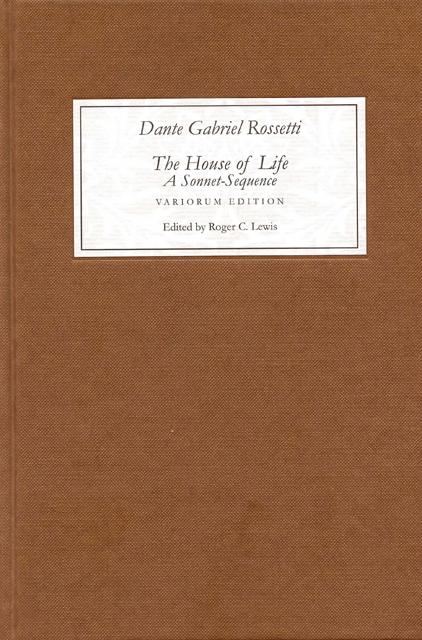 The House of Life by Dante Gabriel Rossetti: A Sonnet-Sequence
The House of Life by Dante Gabriel Rossetti: A Sonnet-Sequence Book contents
- Frontmatter
- Dedication
- Contents
- List of Illustrations
- Acknowledgements
- Note on Edited Text and Apparatus
- List of Abbreviations and Sigla
- Introduction
- Texts and Notes
- Part I Youth and Change
- Part II Change and Fate
- Appendix One Dating and Ordonnance
- Appendix Two Poems: Proof States
- Appendix Three Poems: Chronology 1868–71
- Appendix Four Poems: Bibliographical Summaries
- Appendix Five Ballads and Sonnets (1881): Chronology 1879–82
- Appendix Six Ballads and Sonnets: Bibliographical Summaries
- Appendix Seven Locations of Sources: Concise Survey of Manuscripts, Proofs and Other Documents
- Appendix Eight Unpublished and Excluded Sonnets
- Bibliography of Works Cited or Consulted
Introduction
Published online by Cambridge University Press: 10 March 2023
- Frontmatter
- Dedication
- Contents
- List of Illustrations
- Acknowledgements
- Note on Edited Text and Apparatus
- List of Abbreviations and Sigla
- Introduction
- Texts and Notes
- Part I Youth and Change
- Part II Change and Fate
- Appendix One Dating and Ordonnance
- Appendix Two Poems: Proof States
- Appendix Three Poems: Chronology 1868–71
- Appendix Four Poems: Bibliographical Summaries
- Appendix Five Ballads and Sonnets (1881): Chronology 1879–82
- Appendix Six Ballads and Sonnets: Bibliographical Summaries
- Appendix Seven Locations of Sources: Concise Survey of Manuscripts, Proofs and Other Documents
- Appendix Eight Unpublished and Excluded Sonnets
- Bibliography of Works Cited or Consulted
Summary
The Building of The House of Life
In 1909, Wilfred S. Blunt, author of the sonnet sequence Esther, asserted to Sir Sydney Cockerell that he considered Dante Gabriel Rossetti's 103-sonnet poem The House of Life ‘the greatest of all the great Victorian poems’. This image of its loftiness has been popular among the poem's would-be interpreters, who regard it as an unscaled, perhaps unscalable, pinnacle among Victorian peaks. Certainly, its textual complexities are formidable, and it is impossible to attempt an authoritative interpretation of the House without the benefit of a proper critical edition. The final version, which appeared in Ballads and Sonnets (1881), contained sonnets written as early as 1847, before the formation of the Pre-Raphaelite Brotherhood, and as late as 1880. The individual ‘sonnet-stanzas’ of the House were thus composed over a period of thirty-four years, twice the time it took Alfred Tennyson to compose all the individual lyrics of In Memoriam.
The sequence itself appeared in three different states: 16 sonnets in 1869, published in the Fortnightly Review with the title ‘Of Life, Love, and Death’; 50 sonnets and 11 lyrics published in Poems (1870) with the title ‘Sonnets and Songs, towards a Work to Be Called The House of Life’; 102 sonnets (including an unnumbered proem-sonnet but no songs) published in Ballads and Sonnets (1881) as The House of Life in a two-part sequence with the subtitles ‘Youth and Change’ (59 sonnets) and ‘Change and Fate’ (42 sonnets). Jerome McGann identifies a fourth state (McGann 2003: 386), the Bodleian Library MSS of 30 sonnets and songs that J. R. Wahl published as The Kelmscott Love Sonnets of D. G. Rossetti, but McGann's claim that these documents form ‘a relatively coherent’ version of the sequence is difficult to support. They form no entity and have no unity beyond being a collection of fair copies that Rossetti included in letters to Jane Morris. Some of these poems were never part of any version of the House. Nevertheless, McGann's emphasis on the instability of this long poem is critically sound: it is a house built upon ever-shifting sands.
Some poems added to the final House in 1881 originally appeared in the ‘Sonnets for Pictures and Other Sonnets’ section of Poems (1870).
- Type
- Chapter
- Information
- The House of Life by Dante Gabriel Rossetti: A Sonnet-SequenceA Variorum Edition with Introduction and Notes, pp. 1 - 26Publisher: Boydell & BrewerPrint publication year: 2007


